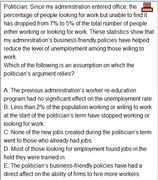Politician: Since my administration entered office, the percentage of people looking for work but unable to find it
has dropped from 7% to 5% of the total number of people either working or looking for work. These statistics
show that my administration's business-friendly policies have helped reduce the level of unemployment among
those willing to work.
Which of the following is an assumption on which the politician's argument relies?
A. The previous administration's worker re-education program had no significant effect on the unemployment
rate.
B. Less than 2% of the population working or willing to work at the start of the politician's term have stopped
working or looking for work.
C. None of the new jobs created during the politician's term went to those who already had jobs.
D. Most of those looking for employment found jobs in the field they were trained in.
E. The politician's business-friendly policies have had a direct affect on the ability of firms to hire more workers.
Answer choice
B, negated:
MORE than 2% of the population working or willing to work at the start of the politician's term have stopped working or looking for work.
Let's examine what the negation of
B implies.
Let the number of people working or willing to work = 1000.
When the politician enters office, 7% can't find work:
Thus, the number unable to find work = .07(1000) = 70.
Today, more than 2% have stopped working/looking, 5% of those looking can't find work:
If 4% have stopped working or looking for work, then the number who have stopped working or looking for work = .04(1000) = 40.
Since 5% of the remaining 960 people are still looking for work but can't find it, the number still looking for work but unable to find it = .05(960) = 48.
Total unemployed = 40+48 = 88.
Thus, the number of people who are unemployed INCREASES from 70 to 88, invalidating the conclusion that the politician's policies have REDUCED unemployment.
Since the negation of
B invalidates the conclusion,
B is the assumption: WHAT MUST BE TRUE for the politician's conclusion to be valid.
The correct answer is
B.
Private tutor exclusively for the GMAT and GRE, with over 20 years of experience.
Followed here and elsewhere by over 1900 test-takers.
I have worked with students based in the US, Australia, Taiwan, China, Tajikistan, Kuwait, Saudi Arabia -- a long list of countries.
My students have been admitted to HBS, CBS, Tuck, Yale, Stern, Fuqua -- a long list of top programs.
As a tutor, I don't simply teach you how I would approach problems.
I unlock the best way for YOU to solve problems.
For more information, please email me (Mitch Hunt) at
[email protected].
Student Review #1
Student Review #2
Student Review #3